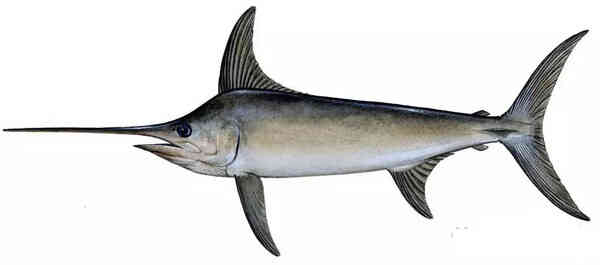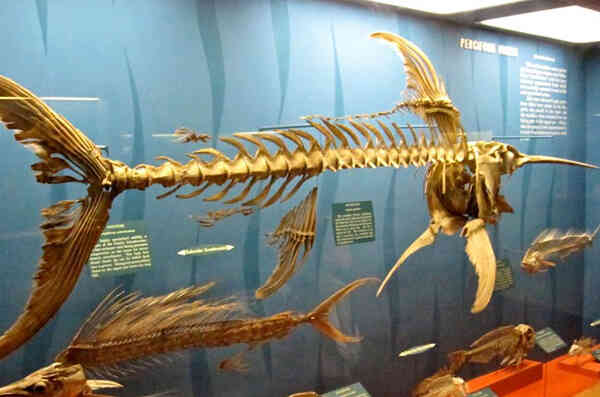Swordfish (scientific name: Xiphias gladius), also known as "arrowfish". It is a common fish in tropical and subtropical oceans in the world. It is named because its upper jaw extends forward in a sword shape. A "speed comparison table of marine animals" published in the Soviet magazine "Nature" in 1967 showed that swordfish has the fastest swimming speed, reaching a speed of 130 kilometers per hour.

Swordfish has a typical streamlined body, smooth surface, long and pointed upper jaw, small dorsal fin, flat mouth, no gills and pelvic fins. Swordfish has different colors, generally brown and black back and body. The average weight of swordfish is 68 to 113 kg, the average length is 2.1 meters, and the mouth accounts for 1/3 of its body length. The main food of swordfish is other fish and squid. Swordfish is distributed in all oceans except the Arctic Ocean. It is also a major edible fish and has important fishery value.
When the swordfish swims forward, the strong tail peduncle can generate huge propulsion, and the long spear-like jaw plays the role of splitting the water. The swordfish moves at a speed of 130 kilometers per hour, and the hard upper jaw can pierce the thick bottom of the boat. In the London Museum in the UK, there is a 50-centimeter-thick wooden bottom of the boat pierced by the swordfish's "long sword".
Swordfish are the top predators in their depth range, and their food includes other pelagic fish, tuna, loaches, flying fish, squid and other cephalopods and crustaceans. Generally, fish cannot maintain their body temperature higher than the temperature of the surrounding water. Swordfish have unique muscles and brown fat tissue to provide warm blood to the brain and eyes, allowing it to reach the extremely cold depths of the ocean. They have almost no natural enemies in the conventional sense, but are sometimes still preyed on by large predators such as killer whales, false killer whales, great white sharks, and mako sharks.
Swordfish have sharp eyesight to observe prey, and their "white" muscles provide energy for their assault activities. Swordfish use their swords to attack prey, tearing the prey into pieces or swallowing it whole. Swordfish feed during the day. They disturb the water up and down, and many small shrimps, fish and squids cannot successfully avoid predators due to changes in light intensity, and eventually become swordfish food.

The young swordfish has delicious meat and can be dried with salt for long-term storage. It can also be processed into canned food, fish sausages, fish ham, etc. This kind of fish is rich in fat and contains a lot of vitamins, potassium, etc.
The French Public Health and Food Safety Department (AFSSA) pointed out that pregnant women, breastfeeding women and infants under 30 months should not eat swordfish. Studies have shown that carnivorous fish such as swordfish are at the end of the food chain and are prone to concentrate a pollutant called methylmercury. This substance appears naturally or occasionally in the environment. Although methylmercury varies with environmental changes, its content in carnivorous fish is relatively high. The central nervous system of young infants and young children will show a specific toxic response to this mercury derivative.
Of course, this type of fish does not have to be completely banned. Pregnant women and breastfeeding women can limit their weekly consumption to 150 grams, and for infants under 30 months old, it is 60 grams.
According to statistics in 2011, the number of this species has dropped by more than 28% in three generations (about 20 years) worldwide. In the Mediterranean, its species reserve is less than 10% of the global total.
How to distinguish swordfish from sailfish:
1. The distance between the first dorsal fin and the second dorsal fin of swordfish is very far.
2. Swordfish has a single body color and an unusually thick tail peduncle; on the contrary, the sailfish family has a more complex body color and a more symmetrical body.
3. The cross section of the swordfish's snout is flat and sharp-edged, similar to a "sword"; the cross section of the swordfish's snout is round, more like a "thin stick".
4. The swordfish's body is bare and scaleless, and has no lateral line; the adult fish of the sailfish family are all covered with ctenoid scales and all have lateral lines.
5. Swordfish have no teeth, while the fish of the sailfish family have tiny teeth.